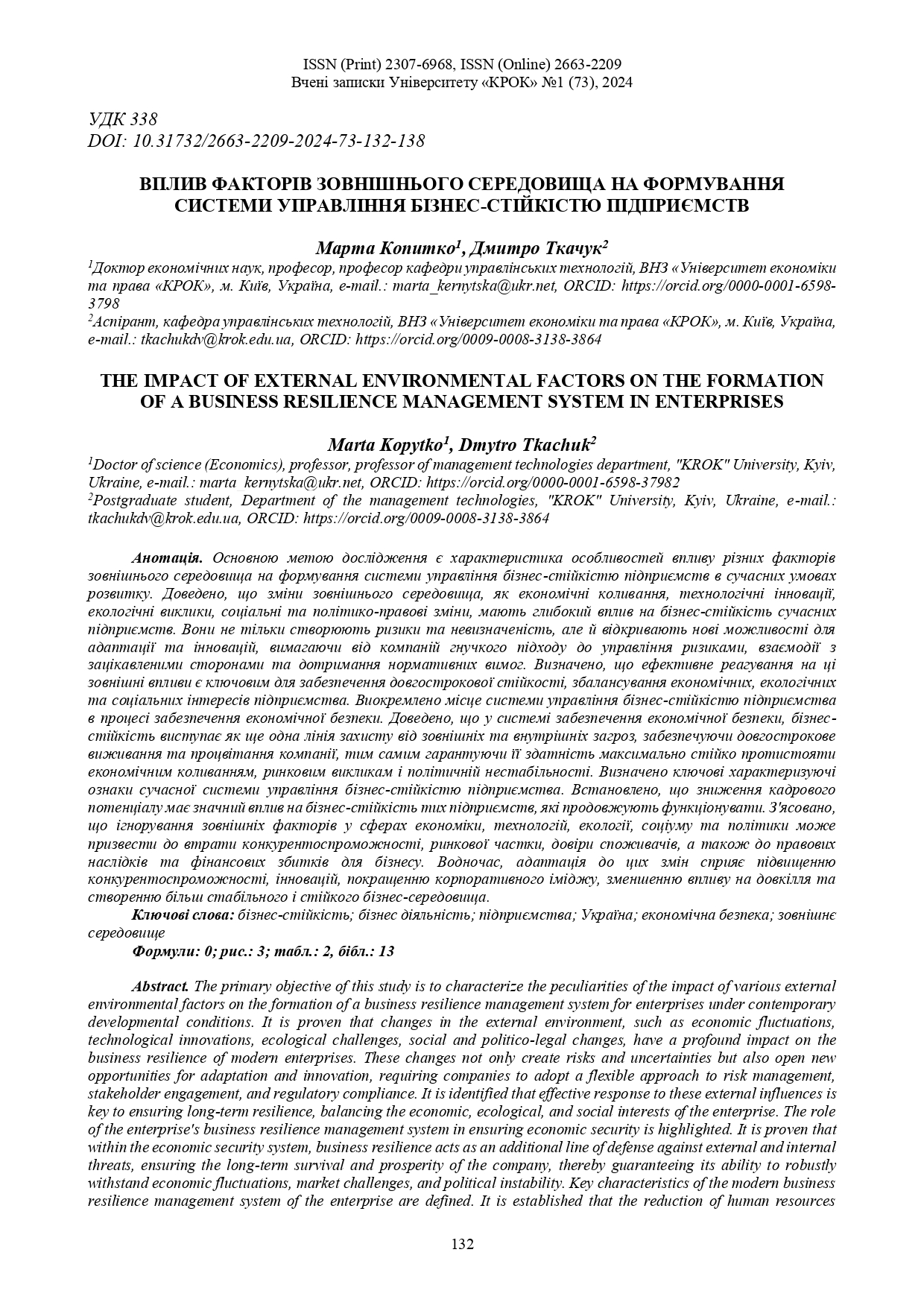THE IMPACT OF EXTERNAL ENVIRONMENTAL FACTORS ON THE FORMATION OF A BUSINESS RESILIENCE MANAGEMENT SYSTEM IN ENTERPRISES
DOI:
https://doi.org/10.31732/2663-2209-2024-73-132-138Keywords:
business resilience, business activity, enterprises, Ukraine, economic security, external environmentAbstract
The primary objective of this study is to characterize the peculiarities of the impact of various external environmental factors on the formation of a business resilience management system for enterprises under contemporary developmental conditions. It is proven that changes in the external environment, such as economic fluctuations, technological innovations, ecological challenges, social and politico-legal changes, have a profound impact on the business resilience of modern enterprises. These changes not only create risks and uncertainties but also open new opportunities for adaptation and innovation, requiring companies to adopt a flexible approach to risk management, stakeholder engagement, and regulatory compliance. It is identified that effective response to these external influences is key to ensuring long-term resilience, balancing the economic, ecological, and social interests of the enterprise. The role of the enterprise's business resilience management system in ensuring economic security is highlighted. It is proven that within the economic security system, business resilience acts as an additional line of defense against external and internal threats, ensuring the long-term survival and prosperity of the company, thereby guaranteeing its ability to robustly withstand economic fluctuations, market challenges, and political instability. Key characteristics of the modern business resilience management system of the enterprise are defined. It is established that the reduction of human resources significantly impacts the business resilience of those enterprises that continue to function. It is discovered that ignoring external factors in the fields of economy, technology, ecology, society, and politics can lead to a loss of competitiveness, market share, consumer trust, as well as legal consequences and financial losses for businesses. Concurrently, adaptation to these changes promotes increased competitiveness, innovation, improvement of corporate image, reduction of environmental impact, and creation of a more stable and resilient business environment.Downloads
References
Alazzam, F. A. F., Tubishat, B. M. A.-R., Savchenko, O., Pitel, N., & Diuk, O. Formation of an innovative model for the development of e-commerce as part of ensuring business economic security. Business: Theory and Practice, 24(2), 2023, 594–603.
Sylkin, O., Shtangret, A., Ogirko, O., & Melnikov, A. Assessing the financial security of the engineering enterprises as preconditions of the application of anti-crisis management: Practical aspect. Business and Economic Horizons (BEH), 14(4), 2018, 926–940.
Žaptorius, J., & Garbanovas, G. Riskiness and interdependencies of business value variables. Business: Theory and Practice, 8(3), 2007, 166-175.
Al-edenat, M., & Alhawamdeh, N. Reconsidering individuals’ competencies in business intelligence and business analytics toward process effectiveness: mediation-moderation model. Business: Theory and Practice, 23(2), 2022, 239–251.
Kopytko, M., Fleychuk, M., Veresklia, M., Petryshyn, N., & Kalynovskyy, A. Management of security activities at innovative-active enterprises. Business: Theory and Practice, 22(2), 2021, 299-309.
Grizovska, L. A. Factors of motivation in increasing the efficiency of innovative activities of an enterprise. Khmelnytsky National University Bulletin, 2, 2014, 90–94.
State Statistics Service. URL : https://www.ukrstat.gov.ua/ (дата звернення 17.02.2024)
Gurieva, L. K., Akhmetshin, E. M., Savicheva, A. N., Kataeva, V. I., & Norkina, A. N. (2016). Theoretical foundations of management of the organization: development, types of structures, management methods of control. International Business Management, 10(22), 2016, 5406–5416.
Ivashchenko, T., Chornodid, I., & Ivashchenko, A. The business assistant service as one of the promising areas for the adoption of AI technologies in the enterprise. Business: Theory and Practice, 21(2), 2020, 588-597.
Farshidi, S., Kwantes, I. B., & Jansen, S. Business process modeling language selection for research modelers. Software and Systems Modeling. 2023, https://doi.org/10.1007/s10270-023-01110-8
Alazzam, F. A. F., Tubishat, B. M. A.-R., Storozhuk, O., Poplavska, O., & Zhyvko, Z. Methodical approach to the choice of a business management strategy within the framework of a change in commercial activities. Business: Theory and Practice, 25(1), 2024, 1–10.
Litvin, N., Grabar, N., Tymofeev, S., Harasym, P., & Myshchyshyn, O. (2021). ASSESSMENT OF THE LEVEL OF ECONOMIC SECURITY OF INNOVATIVELY ACTIVE ENTERPRISES AS THE BASIS OF THE MANAGEMENT PROCESS WITHIN THE FINANCIAL AND LEGAL FIELD. Financial and Credit Activity Problems of Theory and Practice, 4(39), 209–215. https://doi.org/10.18371/fcaptp.v4i39.241310
L. G. Shemayeva, I. P. Mihus, V. M. Shemayev, V. V. Shemayev, & L. M. Melnyk. (2021). APPLICATION OF THE MODEL OF CROSS-OPTIMIZATION OF FINANCIAL AND MATERIAL FLOWS IN THE MECHANISM OF PROVISION OF FINANCIAL SECURITY. Financial and Credit Activity Problems of Theory and Practice, 2(33), 400–410. https://doi.org/10.18371/fcaptp.v2i33.207078

Downloads
Published
How to Cite
Issue
Section
License

This work is licensed under a Creative Commons Attribution-NonCommercial 4.0 International License.

